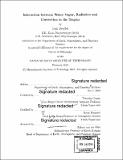Interaction between water vapor, radiation and convection in the tropics
Author(s)
Beucler, Tom(Tom George)
Download1102054503-MIT.pdf (24.42Mb)
Other Contributors
Massachusetts Institute of Technology. Department of Earth, Atmospheric, and Planetary Sciences.
Advisor
Timothy Cronin and Kerry Emanuel.
Terms of use
Metadata
Show full item recordAbstract
The spatiotemporal variability of water vapor near the Equator remains poorly understood because convective organization simultaneously spans the cloud scale (~ 10km) and the planetary scale (~ 10, 000km). Spatiotemporal variability of tropical water vapor may result from internal instabilities of the atmosphere, arising from the interaction between water vapor, radiation and convection. The present work leverages the instability of radiative-convective equilibrium, the most fundamental state of the tropical atmosphere, to connect convective organization in cloud-permitting models with the observed variability of water vapor through common physical mechanisms. First, we propose a simple theory that explains when instability of radiative-convective equilibrium may occur: If the total atmospheric cooling decreases with column water vapor, then radiative-convective equilibrium may be unstable to the growth of moist and dry perturbations. Secondly, we combine a linear response framework with the weak temperature gradient approximation to analyze the interaction between convection, radiation and water vapor at each level of the atmosphere. We find that convection may interact with radiation to trigger the growth of mid-tropospheric water vapor anomalies by transporting water vapor to the upper troposphere, where it can prevent lower-tropospheric water vapor from radiatively cooling to space. Thirdly, we turn to the spatial organization of water vapor anomalies and relate the evolution of the size of moist and dry regions to diabatic fluxes in twenty cloud-permitting simulations on large domains. Longwave radiation from ice clouds aggregates convection at larger scales, shortwave radiation aggregates convection at smaller scales, and surface enthalpy fluxes smooth out water vapor anomalies through their enthalpy disequilibrium component. Finally, we relate the transient zonal variability of precipitable water to convective-aggregation mechanisms in realistic models and observations of the atmosphere. Radiative fluxes generate transient water vapor structures of planetary scales, while surface enthalpy fluxes and horizontal energy transport act to smooth out these structures, suggesting parallels between observations and idealized simulations of aggregated convection.
Description
Thesis: Ph. D., Massachusetts Institute of Technology, Department of Earth, Atmospheric, and Planetary Sciences, 2019 Cataloged from PDF version of thesis. Includes bibliographical references (pages 227-251).
Date issued
2019Department
Massachusetts Institute of Technology. Department of Earth, Atmospheric, and Planetary SciencesPublisher
Massachusetts Institute of Technology
Keywords
Earth, Atmospheric, and Planetary Sciences.